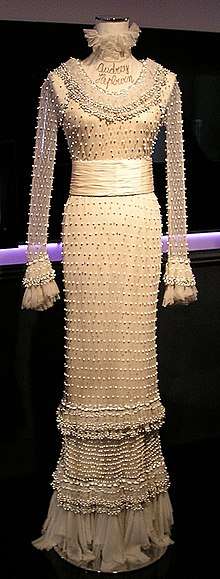Fashion in the United States
The United States is one of the leading countries in the fashion design industry, along with France, Italy, the United Kingdom, Germany and Japan. Apart from professional business attire, American fashion is eclectic and predominantly informal. While Americans' diverse cultural roots are reflected in their clothing, particularly those of recent immigrants, cowboy hats, boots, jeans, and leather motorcycle jackets are emblematic of specifically American styles.
| This article is part of a series on the |
| Culture of the United States of America |
|---|
| Society |
| Arts and literature |
|
| Other |
| Symbols |
|
United States portal |
New York City and Los Angeles are the centers of America's fashion industry. They are considered leading fashion capitals. New York City is generally considered to be one of the "big four" global fashion capitals, along with Paris, Milan and London.
History
Fashion norms have changed greatly between decades. The United States of America has generally followed, and in some cases led, trends in the history of Western fashion. It has some unique regional clothing styles, such as western wear.
Blue jeans were popularized as work clothes in the 1850s by Levi Strauss, an American merchant of German origin in San Francisco, and were adopted by many American teenagers a century later. They are now widely worn on every continent by people of all ages and social classes. Along with mass-marketed informal wear in general, blue jeans are perhaps American culture's primary contribution to global fashion.[1] Other fashion trends started in the US include sports wear as fashion along with athletic shoe wear like Converse or Nike. Athleisure was also popularized in the US around 2012, and as of 2017 the trend has all but dominated the US market. Athleisure has dominated the US market because of its ability to fill a gap in the market, as clothing wasn't usually both comfortable, stylish, and functional. [2]
Fashion industry
The headquarters of many leading designer labels such as Ralph Lauren Corporation, Calvin Klein, Michael Kors, Alexander Wang, Vera Wang, Marc Jacobs, Oscar de la Renta, Diane von Furstenberg, Donna Karan, and Victoria's Secret. Labels such as Abercrombie & Fitch and Eckō Unltd. cater to various niche markets, such as pre teens. A new trend in the United States towards sustainable clothing has led to the emergence of organic cotton T-shirts from labels such as BeGood Clothing. New York Fashion Week is also one of the most influential fashion weeks in the world, and occurs in late summer every year.[3]
Regional and cultural variation
Dress norms in the United States are generally consistent with those of post-industrial Western nations and have become largely informal since the mid-20th century. Clothing in the United States also depends on a variety of factors including location, venue, and demographic factors such as ethnicity. Jeans are a consistent fashion trend among all classes, with variations being vast in both price and style.
The western states are commonly noted for being more informal in their manner of dress than those closer to the eastern seaboard. Conspicuous consumption and a desire for quality have also led to a strong preference for designer label clothing among many in the middle and upper classes.
The tolerance of body expression that deviates from the mainstream, such as complete body tattoos or nudism, is strongly linked to the sub-culture and location in which an individual may find him or herself. The tolerance shown for personal expression such as cross-dressing and piercings varies greatly with location and sub-culture, and may be completely appropriate in one venue while being taboo in another.[4]
Cities such as New York City, Los Angeles, Miami, Dallas, San Francisco, and Chicago are known for their fashion and cosmetics markets. Smaller, but nonetheless prominent fashion destinations are Aspen, Charleston, Washington, D.C., Las Vegas, Seattle, Portland, Atlanta, and Boston.
Some cities and regions have specialties in certain areas. For example, Miami for swimwear, Boston and the general New England area for formal menswear, Los Angeles for casual attire and womenswear, and cities like Seattle and Portland for eco-conscious fashion. Chicago is known for its sportswear, and is the premier fashion destination in the middle American market. Dallas, Houston, Austin, Nashville, and Atlanta are big markets for the fast-fashion and cosmetics industries, alongside having their own distinct fashion sense that mainly incorporates cowboy boots and workwear, greater usage of makeup, lighter colors and pastels, “college prep” style, sandals, bigger hairstyles, and thinner, airier fabrics due to the heat and humidity of the region.
Savannah, Georgia is home to a prominent art and design college, the Savannah College of Art and Design.
References
- Davis, Fred (1992). Fashion, Culture, and Identity. Chicago: University of Chicago Press, p. 69. ISBN 0-226-13809-7.
- Team, Trefis. "The Athleisure Trend Is Here To Stay".
- Guzman, Jacqueline. "The secrets of going sustainable". The Guardian. Retrieved March 15, 2014.
- Thompson, William; Joseph Hickey (1995). Society in Focus. Boston, MA: Pearson. 0-205-41365-X.
